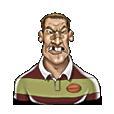Super Turbo SNG
Heads-Up Strategy
Heads-Up Strategy for SNGs - When you make it to the final two players of a Super Turbo Sit-N-Go (or any tournament), you are essentially playing in a cash game. ICM (the Independent Chip Model) no longer applies.
 Anything that's bad for him is good for you, and anything that is good for him is bad for you. When it's 3-handed or more, sometimes a confrontation is bad (on average) for both the caller and the pusher.
Anything that's bad for him is good for you, and anything that is good for him is bad for you. When it's 3-handed or more, sometimes a confrontation is bad (on average) for both the caller and the pusher.
Preflop, the small blind is also the button and acts first. Postflop of course the button is second to act.
By the time a Super Turbo gets down to two players, the effective stacks are usually 12 BBs or less. The effective stack is always equal to the shorter stack of the two. So if one player has 20BBs and the other player has only 7 BBs, then the heads-up strategy for each player should be based on 7 BB stacks (regardless if which one has the bigger or the smaller stack).
Think about it. There are always a total of 2700 chips in play in a Super Turbo, and the blinds are usually 50/100 or higher at that point, so even if you both have 1350 chips, that's only 13.5 BBs. More commonly though the shorter stack will have less than 10 BBs, so you better have a good push-fold game.
Super Turbo heads-up strategy is usually all about push-fold. Here is a link to my article on
"game theory optimal" push-fold strategy.
It includes a push-fold table showing for what size stack you can shove different hands. The information applies for not just Super Turbos but for any SNG, satellite or multi-table tournament heads-up situation as well.
Some study away from the table can be very helpful. If you want to be a good player, there's no excuse for not having a default button open pushing range memorized or on paper. Then you can choose to deviate from the default depending on how loose of a caller you think your opponent is.
You also need to have a default calling range (see link at bottom of page) for when your opponent open shoves against you.
I like keeping a "cheat sheet" handy while I am playing to remind myself of the default ranges I push or call with when I am heads-up. Although I have the information pretty much memorized, sometimes in the heat of the moment I draw a mental blank, especially when I am playing a bunch of tables, so it's nice to have the cheat sheet there as a reference.
My cheat sheet is just a single sheet of paper, and it contains default ranges for heads-up play as well as some
early game shoving ranges
and general reminders.
And for calling all-ins see...
Heads-Up Strategy: Game Theory Optimal Calling Strategy